The work in kit
Let’s start from the evidence: there is a box with plastic material to assemble and the procedural prerequisite is DIY.
This is the direct invitation of the operation of Umberto Cavenago: to make the creative experience their own, to learn a discipline, to conform to a statute, to project oneself into a science, but on a reduced scale.
The package contains a real assembly kit to build the sculpture La 74 in 1:35 scale. The world to be discovered is one that refers back to the realm of model making, which is basically a hobby consisting in making scale reproductions of machines, objects, people or buildings, and which has its origins in the habit of certain craftsmen of past centuries to make small-scale copies of their products to be able to show them to customers. So this model is a tailor-made product for a customer-collector who is invited to put himself to the test: after the test, he can reproduce real or imaginary scenarios of private or public museums, in which to insert every kind of subject and work, and in particular, this small La 74.
Of course, among the most widespread scenarios we find the plastic subjects of the railways, the automobile paths, the battlefields, the automobile tracks, but it is not to be underestimated and excluded this new possibility, which is formed on the hypothesis of a possible diorama of museums, galleries, fairs and so on. In this case, a hypothetical collector can use the model as a substitute and simulacrum for the large and heavy original work, and organize his own mini-museum or even real models, dioramas, in which to place the element of his art collection in Lillipuzian version.
Static modeling involves a good degree of simulation of reality, a change of scale.
Cavenago invites us to reconsider our gaze and to rediscover the amazement of children, with a toy model, with an innocent game, but do not expect something easy and quick to assemble. There is an instance that silently accompanies the box: it is that of fatigue. The work requires an act of personal effort, even if minimal. There is an operational mode that requires putting into practice one’s loyalty to the sense of doing, because if one wants to see the complete work one has to put oneself to the test and get out of what to do? to get to work, and express one’s sense of solidarity towards the goal to be achieved. As they say, “what you buy with difficulty, you get more expensive”.
The wisdom of doing is not an accessory, a fascination, but is intrinsic to the condition of the very purpose: in this case, to assemble the kit. In this game, prescriptive rules are important and there is a main road to follow. There is an individual process that is made up of moments of dedicated attention, concentration, calculated risk, unexpectedness, cognitive investigation of the parts of the assorted equipment of which the kit is composed, of pieces that are destined for a specific function and only for that, of precise instructions that precede all the steps. There are no arbitrary choices but rules to follow, because here it is necessary to follow the traces and follow with precision the patterns, so that at the end of the work you discover the pleasure of the technique that comes true. It is the discovery and amazement of the work of art. In order not to be mistaken, the suggestion is to program the efforts in the smallest detail, to get all the necessary tools to make the model (here carefully supplied together with the kit), and finally to divide the working time into steps.
The actual construction practice (as in the large Cor-Ten steel original measuring 216×205×300 cm) puts into action a procedure where nothing is left to chance, where imagination leaves the field to method and instruction, even if in miniature.
There is a technical data sheet that is not just information, but a real iconographic transparency prepared to take you where you need to go. It is necessary to put into practice the sense of responsibility in doing, because fidelity is not an optional, but an almost ritualistic act, which brings the result of the effort, according to the degree of attention with which one dedicates oneself to the work, towards a happy construction or towards an unhappy construction (which then amounts to the destruction of the work). For the love of art we take refuge in these calibrated moments of play and elaborate idleness. Yes, a game, a real ludus, a pure game, which Roger Caillois already indicated to us as a space for manoeuvre in which to reproduce in a protected environment, some impulses present in reality (from his list of poetry-catalogue I extract, for example; the satisfaction obtained by combinatorial art, the balance of ingenuity, the development of rules and norms, the duty to respect them, the temptation to circumvent them...) therefore a diversion-entertainment, where the primary impulses are let go yes in the reality of the game, but always return to the real world.
A further reason for reflection is to capture in the miniature the playful aspect, as opposed to the far more terrible aspect of its original ideal model, from which everything started, a war machine that for the indomitable Marinetti and Futurist spirits arose as a symbol of an energetic technological progress, that is, from the evocative reinterpretation of the futuristic Lancia-Ansaldo 1ZM armored car of 1918, for the poet Marinetti “fast steel alcove, created to receive the naked body of the Italy naked’.
For his part, Cavenago, with his large La 74 of 2006, a sculptural work on wheels, self-propelled and habitable (with attached a symbolic alcove consisting of two habitable bunk beds of military inspiration), had already brought the warlike representation of this means of offence to zero, simplifying its attributes, eliminating its jagged edges and continuous edging, highlighting, by default, the basic primacy of the form, transforming it into a stocky and minimal body, thus emphasizing its essence as an ancestral container. The pedestal that we expect to see used as a detachment and aesthetic isolation of an object is replaced here by the world, in fact a mini-world, developed just at the level of the floor, or at the edge on a table top, where glue and scalpel are the privileged tools of a related creative universe of instruction manuals.
Luca Scarabelli
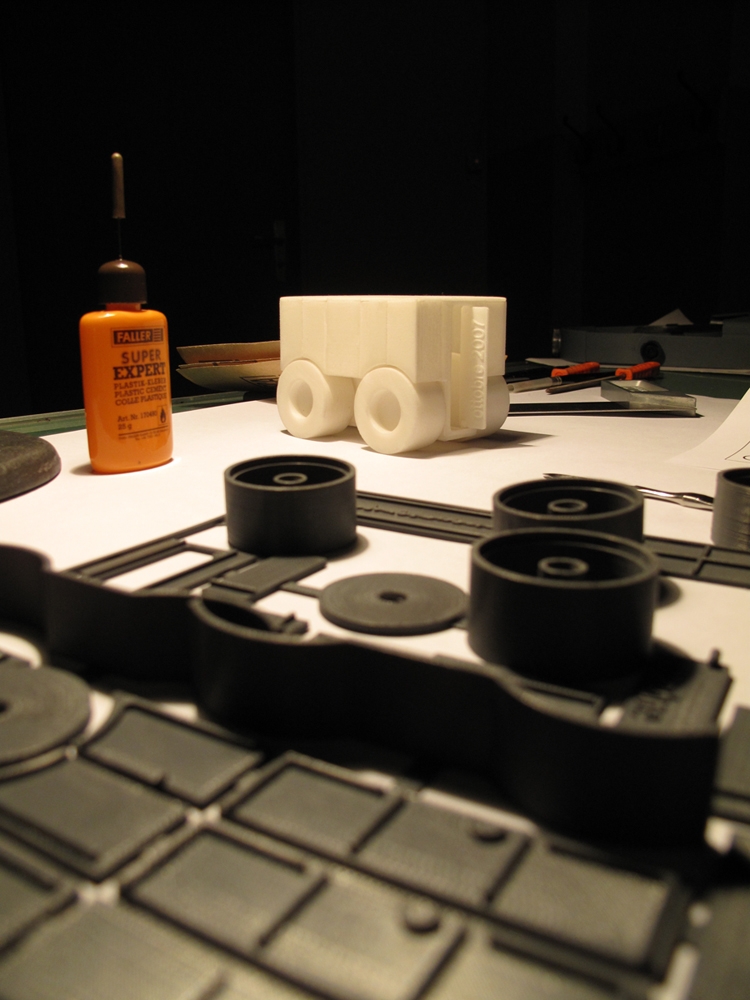
Installation at "La Rada", Locarno
Photo @ Umberto CavenagoThe work in kit
Let’s start from the evidence: there is a box with plastic material to assemble and the procedural prerequisite is DIY.
This is the direct invitation of the operation of Umberto Cavenago: to make the creative experience their own, to learn a discipline, to conform to a statute, to project oneself into a science, but on a reduced scale.
The package contains a real assembly kit to build the sculpture La 74 in 1:35 scale. The world to be discovered is one that refers back to the realm of model making, which is basically a hobby consisting in making scale reproductions of machines, objects, people or buildings, and which has its origins in the habit of certain craftsmen of past centuries to make small-scale copies of their products to be able to show them to customers. So this model is a tailor-made product for a customer-collector who is invited to put himself to the test: after the test, he can reproduce real or imaginary scenarios of private or public museums, in which to insert every kind of subject and work, and in particular, this small La 74.
Of course, among the most widespread scenarios we find the plastic subjects of the railways, the automobile paths, the battlefields, the automobile tracks, but it is not to be underestimated and excluded this new possibility, which is formed on the hypothesis of a possible diorama of museums, galleries, fairs and so on. In this case, a hypothetical collector can use the model as a substitute and simulacrum for the large and heavy original work, and organize his own mini-museum or even real models, dioramas, in which to place the element of his art collection in Lillipuzian version.
Static modeling involves a good degree of simulation of reality, a change of scale.
Cavenago invites us to reconsider our gaze and to rediscover the amazement of children, with a toy model, with an innocent game, but do not expect something easy and quick to assemble. There is an instance that silently accompanies the box: it is that of fatigue. The work requires an act of personal effort, even if minimal. There is an operational mode that requires putting into practice one’s loyalty to the sense of doing, because if one wants to see the complete work one has to put oneself to the test and get out of what to do? to get to work, and express one’s sense of solidarity towards the goal to be achieved. As they say, “what you buy with difficulty, you get more expensive”.
The wisdom of doing is not an accessory, a fascination, but is intrinsic to the condition of the very purpose: in this case, to assemble the kit. In this game, prescriptive rules are important and there is a main road to follow. There is an individual process that is made up of moments of dedicated attention, concentration, calculated risk, unexpectedness, cognitive investigation of the parts of the assorted equipment of which the kit is composed, of pieces that are destined for a specific function and only for that, of precise instructions that precede all the steps. There are no arbitrary choices but rules to follow, because here it is necessary to follow the traces and follow with precision the patterns, so that at the end of the work you discover the pleasure of the technique that comes true. It is the discovery and amazement of the work of art. In order not to be mistaken, the suggestion is to program the efforts in the smallest detail, to get all the necessary tools to make the model (here carefully supplied together with the kit), and finally to divide the working time into steps.
The actual construction practice (as in the large Cor-Ten steel original measuring 216×205×300 cm) puts into action a procedure where nothing is left to chance, where imagination leaves the field to method and instruction, even if in miniature.
There is a technical data sheet that is not just information, but a real iconographic transparency prepared to take you where you need to go. It is necessary to put into practice the sense of responsibility in doing, because fidelity is not an optional, but an almost ritualistic act, which brings the result of the effort, according to the degree of attention with which one dedicates oneself to the work, towards a happy construction or towards an unhappy construction (which then amounts to the destruction of the work). For the love of art we take refuge in these calibrated moments of play and elaborate idleness. Yes, a game, a real ludus, a pure game, which Roger Caillois already indicated to us as a space for manoeuvre in which to reproduce in a protected environment, some impulses present in reality (from his list of poetry-catalogue I extract, for example; the satisfaction obtained by combinatorial art, the balance of ingenuity, the development of rules and norms, the duty to respect them, the temptation to circumvent them...) therefore a diversion-entertainment, where the primary impulses are let go yes in the reality of the game, but always return to the real world.
A further reason for reflection is to capture in the miniature the playful aspect, as opposed to the far more terrible aspect of its original ideal model, from which everything started, a war machine that for the indomitable Marinetti and Futurist spirits arose as a symbol of an energetic technological progress, that is, from the evocative reinterpretation of the futuristic Lancia-Ansaldo 1ZM armored car of 1918, for the poet Marinetti “fast steel alcove, created to receive the naked body of the Italy naked’.
For his part, Cavenago, with his large La 74 of 2006, a sculptural work on wheels, self-propelled and habitable (with attached a symbolic alcove consisting of two habitable bunk beds of military inspiration), had already brought the warlike representation of this means of offence to zero, simplifying its attributes, eliminating its jagged edges and continuous edging, highlighting, by default, the basic primacy of the form, transforming it into a stocky and minimal body, thus emphasizing its essence as an ancestral container. The pedestal that we expect to see used as a detachment and aesthetic isolation of an object is replaced here by the world, in fact a mini-world, developed just at the level of the floor, or at the edge on a table top, where glue and scalpel are the privileged tools of a related creative universe of instruction manuals.
Luca Scarabelli
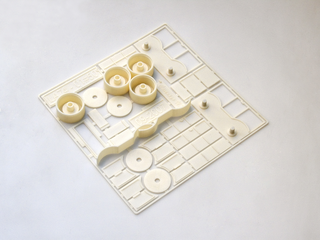
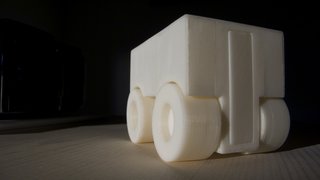
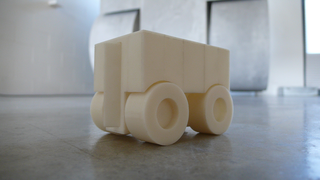
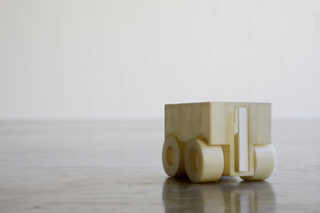
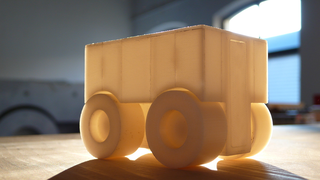
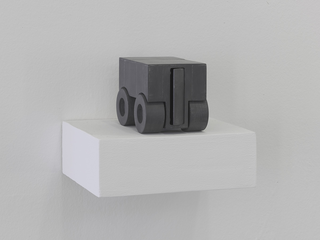
Solo exhibition, "Fioretto Arte Contemporanea", Padova 2007
Photo @ Alessandro Zambianchi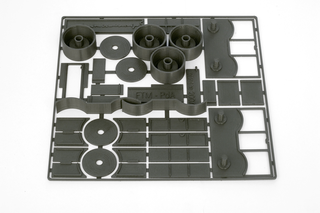
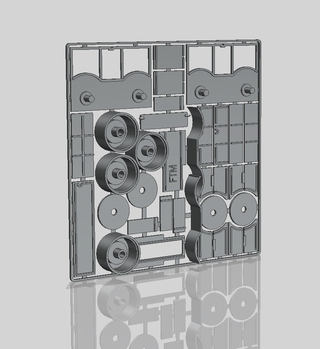
Social
Contatti
umberto@cavenago.info